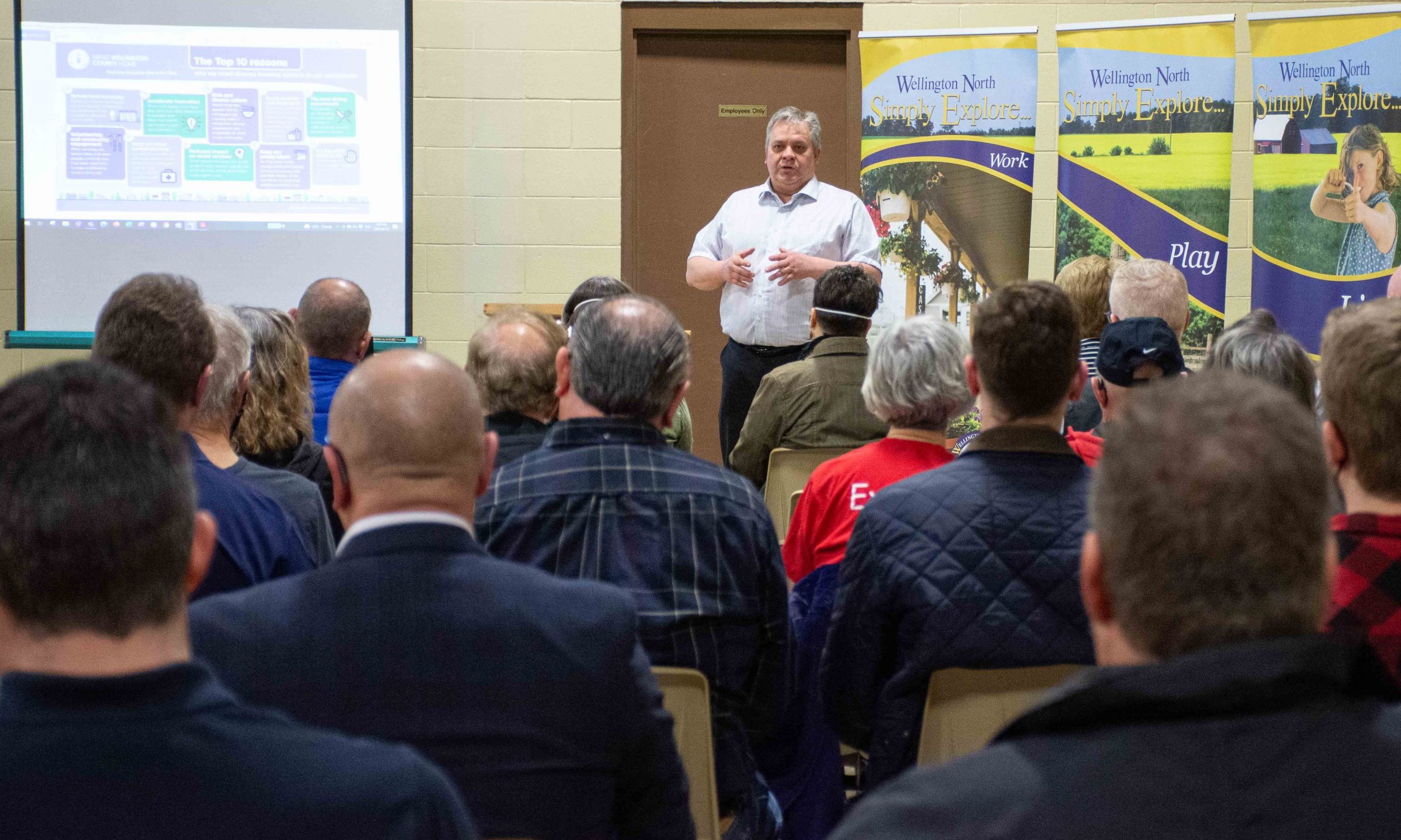ARTHUR – There’s no denying Wellington North will experience its fair share of growing pains in the coming decades, as officials spur on economic growth and the housing to support it.
At an April 13 public forum, township officials spoke about growth, housing and development before a gathering of around 70 developers, realtors, business and health care stakeholders, township and county officials, service club members, and residents.
In his opening remarks at the Arthur Community Centre that Wednesday, Mayor Andy Lennox said he wants incoming residents to share in a sense of belonging, and for the township not to become a “bedroom community.”
“We knew growth was coming, we never imagined the kind of pace that we’re facing right now,” Lennox said.
“I think we need all of you to be a part of this discussion so that we make the right choices for our community, not just for today but for 10 years, 20 years, and 30 years down the road.”
Incentivizing growth
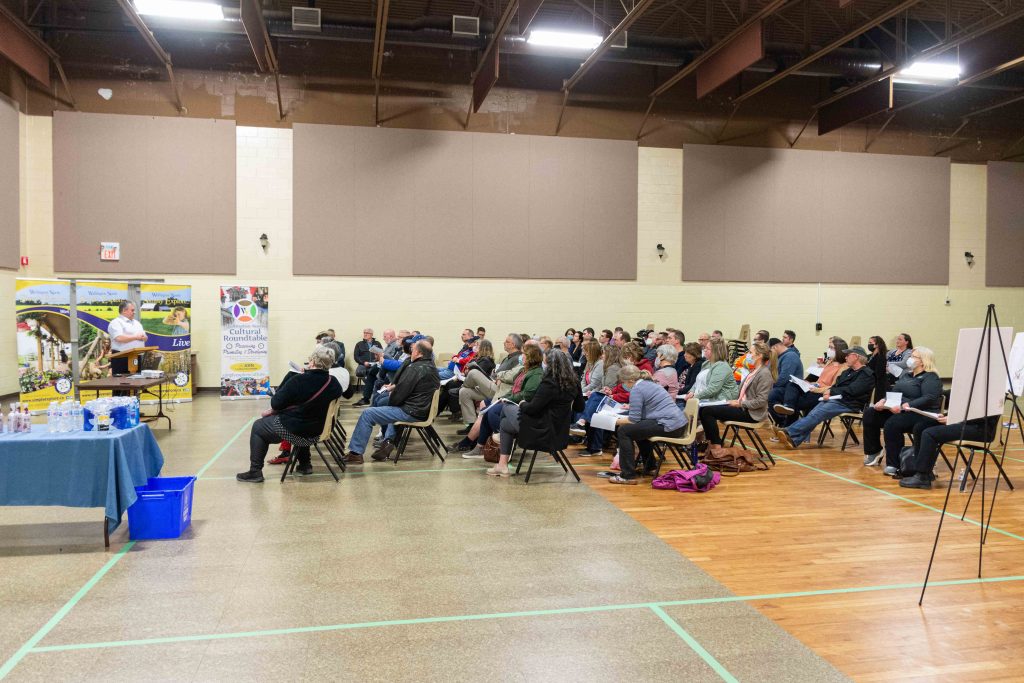
Around 70 people gathered at the Arthur Community Centre for an April 13 public forum discussing growth, housing and development. Photo by Jordan Snobelen
Over the next three decades, the township is expected to accommodate an additional 8,000 people, another 3,200 employment opportunities, and an average of 80 to 90 new residential builds each year, according to CAO Mike Givens.
“We heard from the employers within this community that they need workers and that we should do all we can to accommodate more housing stock in the community,” he said.
Highlighting how the township has responded, Givens noted significant investment in Arthur’s wastewater treatment plant, reduced development charges for rental buildings, and a 2021 zoning bylaw amendment to accommodate additional dwelling units on already existing properties, and houses.
Developers also get a break in charges to encourage development downtown, and where services and municipal infrastructure already exist.
Amendments to zoning bylaws were also made in 2018, reducing lot sizes to pack in more housing.
Demand for housing here, Givens said, is unlike anything the township has seen before.
Expansion will force councillors to weigh one development against another in deciding what moves ahead and what waits, so long as council wishes to control the pace of development and avoid a boom scenario.
“Those are difficult decisions that are going to have to be made,” Givens said.
The CAO acknowledged the “real” stress from growth and called for investment in a transportation master plan, as well as an employment land development strategy to guide the future.
“And we need to do it now, not after the development is here,” he emphasized. “We can’t lose sight of what the future looks like.”
‘Unprecedented’
Peering into the future fell onto township chief building official Darren Jones, who said 364 building permits were issued in 2021 – an “unprecedented amount.”
That’s an 82 per cent increase over the 200 permits the township typically issues in a year, an increase Jones attributes directly to new residential builds and large additions.
As for the 80 to 90 new households per year Givens referred to, those numbers are expected to double, Jones said.
Speaking to the increased demand on finite services that more housing brings, Jones said the township is “looking at the idea of front-ending agreements where developers pay for municipal infrastructure upfront and are paid back through development charges as their development proceeds.”
Perhaps the most finite of all municipal services is Arthur’s limited wastewater treatment plant capacity.
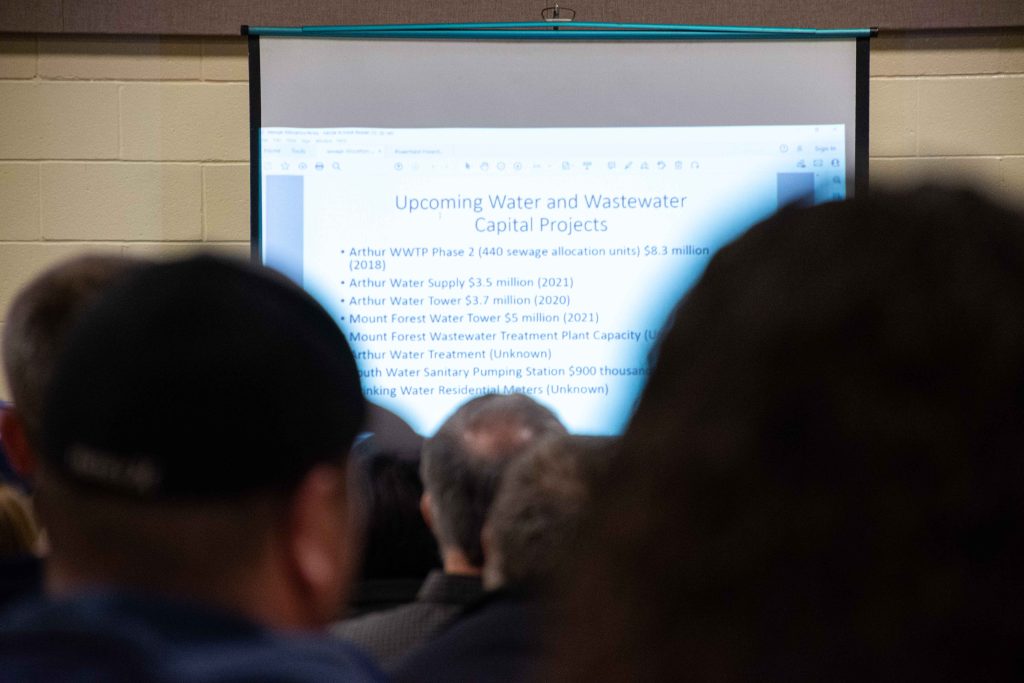
A slide displays upcoming water and wastewater capital projections, along with their associated costs at an April 13 public forum held at the Arthur Community Centre. Photo by Jordan Snobelen
Operations director Matt Aston said a second upgrade is needed to accommodate future growth.
Without further capacity opened up at the plant, future development in the village could come to a standstill.
As the Advertiser previously reported, a February report from township development clerk Tammy Pringle suggests future development of new residential units is expected to “make use of more than the [current] wastewater treatment plant capacity” and a second upgrade – combined.
Aston also listed future water-related projects, including a new well for drinking water and two new water towers, all in excess of $20 million, and requiring upwards of 45 years to bring to fruition.
Housing and employment
An underlying theme of Wednesday’s forum was housing viewed from an economic benefit perspective, as it relates to local employers.
At the county level, Jana Burns, administrator of the county museum and economic development, spoke about the county’s “Make Wellington County Home” campaign encouraging residents to envision housing options beyond single-family detached homes.
“From an economic development perspective, it’s critical we look at housing to stay competitive,” Burns said.
“Everyone should be able to live here” is the county’s campaign tagline.
But with vacancy rates at less than one per cent, and astronomical housing prices as far as the eye can see, for many the option of living here is simply eliminated.
Burns said employers are having difficulty filling job vacancies, and housing needs to diversify.
“Smart, young people are coming here for great jobs, but they can’t find an affordable apartment,” she said.
A lack of affordable and attainable housing also affects seniors wanting to downsize, and new Canadians wanting to come to the county, Burns said.
In a phone interview a day after the forum, Wellington North’s economic development officer Dale Small, who facilitated the forum, said challenges surrounding employment and housing are “only going to increase.”
The responsibility for solutions doesn’t fall onto the shoulders of a municipality alone, Small said, but also on employers to understand what they can do to “not only support the housing, but also to support themselves in terms of workforce attraction.”
As an example, Small suggested private-public partnerships to produce housing specific to a manufacturer, and said housing solutions need to be creative.
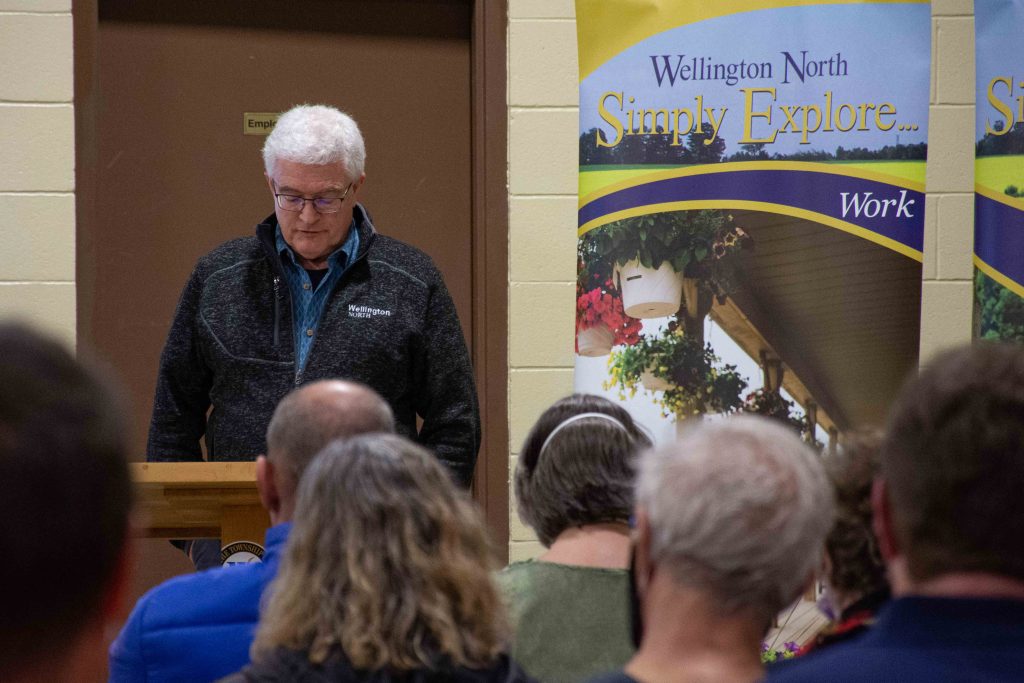
Wellington North economic development officer Dale Small speaks to around 70 people gathered at the April 13 public forum. Photo by Jordan Snobelen
Public sessions on growth were held during the township’s Community Growth Plan process in 2017.
But discussions then were geared to diversifying housing options and preparing residents for the growth to come.
“Here we are five years later … it’s no longer coming, it’s here,” Small said.
Now discussions are around more creative options.
“In Wellington North those haven’t really been at the forefront of any of our discussions, but now they are,” Small said.
“The conversations are starting to happen. We’re seeing some of our larger employers that may be more interested in having those discussions now.”
‘Everybody needs to be involved’
An open question and answer session followed official presentations, with residents asking about developers paying for municipal infrastructure, crime rates, low-income housing, water project timelines, traffic concerns, and reducing red tape to get houses built.
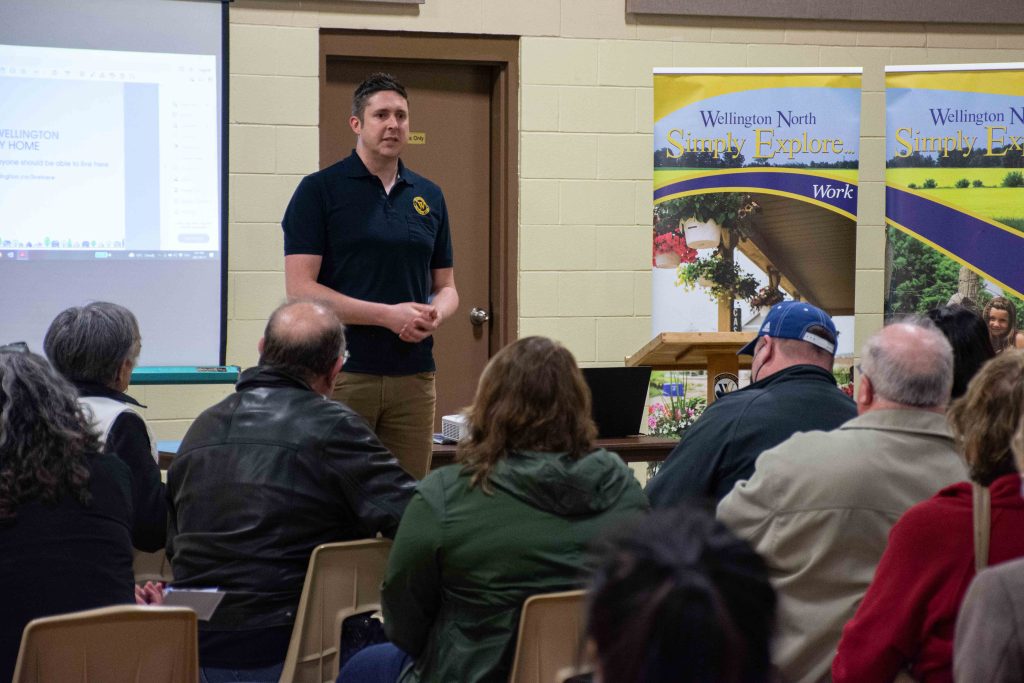
Wellington North chief building official Darren Jones responds to a question during an April 13 public forum about “front-ending agreements” where developers would have the option of paying for municipal infrastructure upfront and be repaid through development charges later on. Photo by Jordan Snobelen
Hans and Marilyn Theurer, residents of Arthur since 1969, said they attended the forum to stay informed about what’s happening in their community.
The couple have noticed significant changes in the village over the last few years.
“You see it going on, you only have to drive along Wells Street,” Marilyn remarked.
“It’s just we haven’t seen this much development in Arthur since we’ve lived here.”
Marilyn appreciates a controlled pace to development, giving residents a “chance to get used to it” and Hans said communicating with the community is a step in the right direction.
Based on the amount of people who participated during the 2017 growth plan process, compared to the amount of people who attended Wednesday’s forum, Small said people weren’t as engaged before.
“There wasn’t as much engagement because it wasn’t as real; well, it’s real now to everyone,” he remarked.
Part of the mission, Small admits, is trying to get residents to see growth not as an issue, but an opportunity to be seized.
“Let’s not lose sight of the fact that having increased population growth gives us lots of benefits and lots of opportunities to help improve our community,” he said.
Community engagement will be a focus in the long journey ahead, Small assured, saying “everyone in the community will be significantly impacted.”
“Everybody needs to be involved in this discussion, it isn’t just about developers building homes, it’s bigger than that.”




